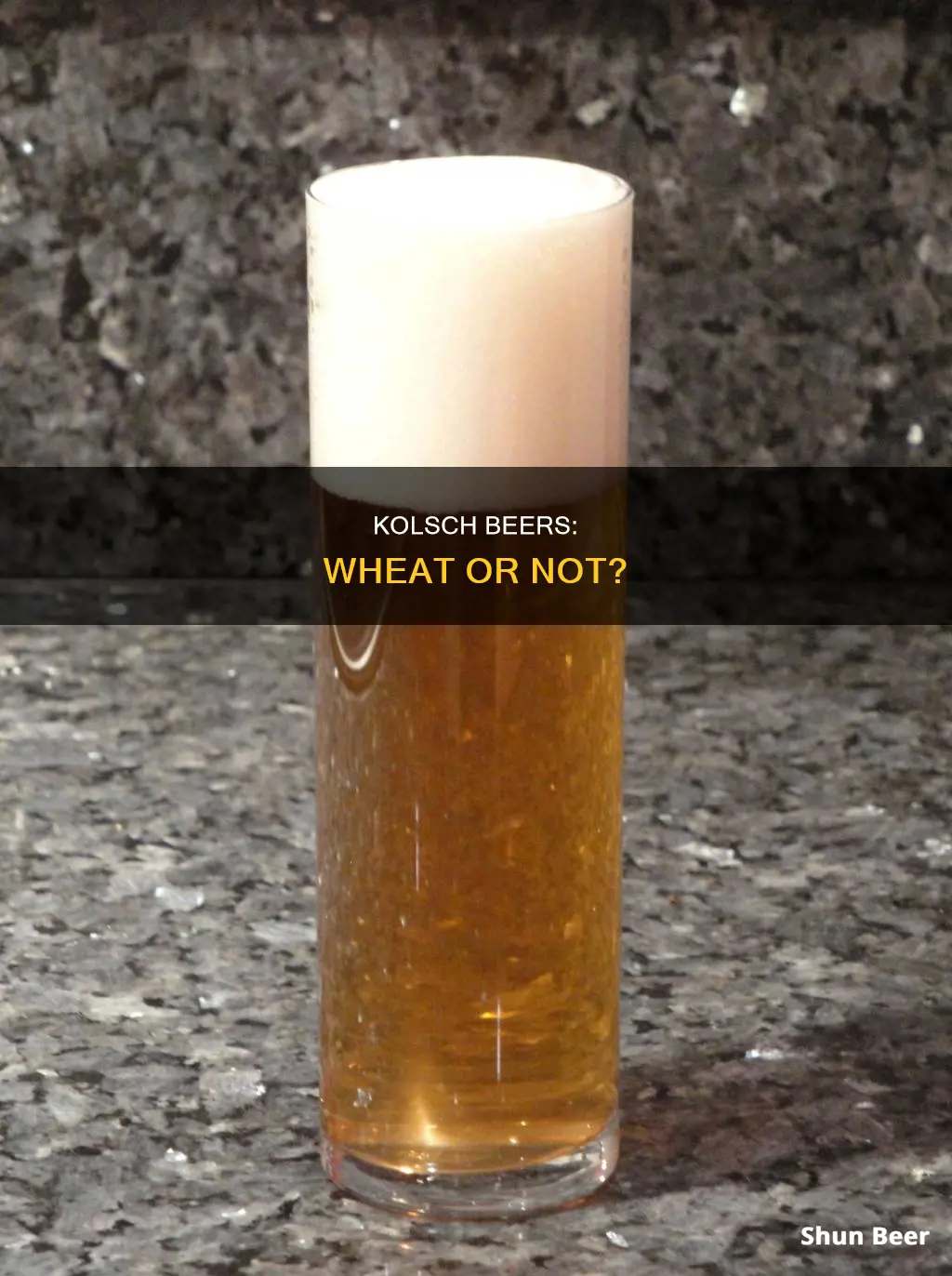
The German ale known as Kölsch (pronounced 'kœlʃ') is a hybrid style of beer that combines the best elements of a lager and an ale. It is fermented with ale yeast and then finished at cold temperatures like a lager. This unique brewing technique gives it a refreshing, balanced taste with a subtle fruitiness and a crisp, dry finish. While Kölsch is not a wheat beer, some breweries add up to 20% malted wheat to the grain bill.
| Characteristics | Values |
|---|---|
| Origin | Cologne, Germany |
| Appearance | Bright, clear, straw-yellow, light gold |
| Flavour | Subtly complex, creamy, soft, fruity, bready, hoppy |
| Alcohol Content | Low to medium |
| Fermentation | Top-fermenting |
| Yeast | Ale yeast |
| Hops | Noble hops |
| Malt | Pilsner malt, wheat malt |
What You'll Learn

Kölsch is a German ale
Kölsch is characterised by its crisp drinkability and exceptional balance of malt and fruit flavours. It is light in colour, ranging from a straw-yellow to a pale golden hue, and has a mildly fruity profile with subtle spice. The fermentation process yields a light, vinous character with a slightly dry, crisp finish.
Kölsch is warm fermented with top-fermenting yeast, then conditioned at cold temperatures like a lager. This brewing process is known as lagering, which refers to a particular method of fermentation and storage in cold temperatures. The use of a hybrid brewing technique blurs the lines between ale and lager, as it is fermented with ale yeast and then finished at cold temperatures like a lager.
Technically, for a beer to be called a Kölsch, it must come from the city of Cologne and be brewed according to the Kölsch Konvention defined by the members of the Cologne Brewery Association. The term "Kölsch" has had a protected geographical indication (PGI) within the European Union since 1997, indicating a beer made within 50km of Cologne.
Kölsch is traditionally served in a tall, thin, cylindrical 200-millilitre glass called a Stange, and it is a popular choice for beer lovers and craft brewers alike. It pairs well with traditional German foods such as bratwurst, nutty cheeses, and lighter desserts.
Wheat Beers and Psoriasis: A Cloudy Concern?
You may want to see also

It's a hybrid beer
The Kölsch is a hybrid beer. It is a combination of top-fermenting and bottom-fermenting beer styles.
Kölsch is a German beer style that originated in Cologne (Köln) in the 13th century and gained popularity in the 19th and 20th centuries. It is a clear, pale gold beer with a slight effervescence and a foamy white head. The beer is brewed using a top-fermenting process, similar to that of wheat beers such as Hefeweizen and Witbier. However, what sets Kölsch apart is that it is then cold-conditioned like a lager, resulting in a hybrid brewing process that combines the characteristics of both ale and lager brewing.
The primary difference between Kölsch and wheat beers lies in the grains used for brewing. Kölsch is brewed primarily with Pilsner malt, which is a barley-based malt, while wheat beers are brewed with a significant portion of wheat malt. The aroma of a Kölsch is delicate, with subtle fruity notes and a hint of hoppy spiciness, while wheat beers have a more pronounced aroma with notes of banana and clove.
Kölsch has a unique taste and flavour profile due to its hybrid brewing process. It has a crisp, clean flavour with a slightly sweet malt backbone and a subtle hop bitterness. The light to medium body of Kölsch gives it a smooth and refreshing mouthfeel, while wheat beers tend to have a creamier, fuller mouthfeel due to the higher protein content in wheat malt, which contributes to a more substantial body.
Kölsch is often considered a hybrid beer as it combines the fermentation and storage methods of both ales and lagers. The Germans refer to it as a "top-fermenting lager" because they use the word "lagered" to describe a particular method of fermentation and storage in cold temperatures. The specific nature of the yeast used to brew Kölsch also contributes to its hybrid classification.
Belgian Beers: Wheat-Based Brews or Not?
You may want to see also

It's fermented with ale yeast
Kölsch is a style of beer that originated in Cologne, Germany. It is a top-fermented beer, which means that it is fermented with ale yeast. This is an important distinction, as the type of yeast used to ferment a beer determines whether it is classified as an ale or a lager.
In the case of Kölsch, the ale yeast used for fermentation prefers colder temperatures than those typically used for ales, but these temperatures are still higher than what bottom-fermenting lager yeasts prefer. So, while Kölsch is technically an ale, it is often referred to as a "hybrid ale" or a "lagered ale". This means that it is fermented with ale yeast but at cooler temperatures and then stored at cold temperatures like a lager.
The fermentation process for Kölsch involves using a specific type of ale yeast, such as the German 177 strain or proprietary strains used by some brewers. The fermentation temperature is crucial and should be maintained between 55 to 59 degrees Fahrenheit, with nothing exceeding 72 degrees Fahrenheit. The yeast can produce strong off-flavours at high temperatures, so it is important to closely monitor the fermentation process.
After fermentation, the beer is conditioned at cold temperatures, similar to the process used for Düsseldorf's altbier. This combination of top fermentation with ale yeast and cold conditioning gives Kölsch its unique characteristics, blending the hoppy goodness of an ale with the light, refreshing endnotes of a lager.
The Kölsch style has a rich history that dates back several hundred years. It was first called "Kölsch" in 1918 to describe the beer brewed by the Sünner brewery since 1906. The term "Kölsch" now has a protected geographical indication within the European Union, indicating a beer made within 50km of Cologne and brewed according to the Kölsch Konvention, which sets strict standards for its production.
Wheat Beer Allergies: Understanding the Connection and Symptoms
You may want to see also

It's finished at cold temperatures
Kölsch is a style of beer originating in Cologne, Germany. It is a top-fermented beer, warm fermented with top-fermenting yeast, then conditioned at cold temperatures like a lager. This is because, historically, bottom-fermented beers rose in popularity, threatening the business interests of Cologne's brewers, who only produced top-fermented beers.
In response, the town council of Cologne in 1603 forced young brewers to swear an oath to continue using top-fermenting yeast. In 1676 and 1698, the council again tried to legislate against bottom-fermented beer by forbidding its sale within the city walls. However, by 1750, Cologne brewers were competing with bottom-fermented beers by using a hybridised brewing process, first brewing their beer using top-fermenting yeast, and then ageing the beer in cold cellars like bottom-fermented beer.
Kölsch is therefore a lagered ale. It is fermented by a top-fermenting yeast (ale yeast) but at cooler temperatures and then stored at cool/cold temperatures like a lager. The yeast used for Kölsch likes colder temperatures than warm-loving ale yeasts, but this temperature is still higher than what bottom-fermenting lager yeasts prefer.
Kölsch is best served fresh and around cellar temperature.
Beer and Wheat: What's the Connection?
You may want to see also

It's a refreshing, drinkable beer
The Kölsch is a refreshing, drinkable beer with a fascinating history. It is a hybrid, a combination of the best elements of a lager and an ale. This unique brew is perfect for any occasion.
Kölsch is a style of beer that originated in Cologne, Germany. It is bright and clear with a straw-yellow hue. It is warm fermented with top-fermenting yeast and then conditioned at cold temperatures like a lager. This gives it a light, refreshing quality that makes it highly drinkable.
The taste of Kölsch is subtly complex, with a perfect balance of malt and fruit flavours. It has a crisp, smooth profile and is partially bready, with a touch of subtle fruitiness and spice. The fruity notes are never overwhelming, and are complemented by a politely hoppy bite that counters a controlled malty sweetness. The rounded flavour leads to a dry finish.
Kölsch is an excellent choice for warm summer days and pairs well with food, including traditional German sausages, kraut, and nutty cheeses. It is also a fun beer to enjoy with lighter desserts like apricot cake.
Kölsch is an exquisitely crafted beer. It is one of the most elegantly aromatic, flavourful yet not taste bud-arresting, refreshing, crisp, and gorgeous beers you can ever taste. It is a very clean ale that delivers a refreshing and enjoyable drinking experience to the palate.
Hefeweizen: Wheat Beer, But Different
You may want to see also
Frequently asked questions
Kölsch is a style of beer originating in Cologne, Germany. It is a clear, pale gold, top-fermented beer with a light grainy malt character and a soft mouthfeel. It is fermented at warm temperatures and then conditioned at cold temperatures like a lager.
No, Kölsch beers are not wheat beers. They are primarily made with light pilsner malt, although some breweries may add a small amount of wheat malt (up to 20%).
Kölsch beers are fermented with ale yeast at warm temperatures, resulting in fruity and bready flavours. Lagers, on the other hand, are made with bottom-fermenting yeasts at cooler temperatures, leading to crisper, more malt-forward flavours.







